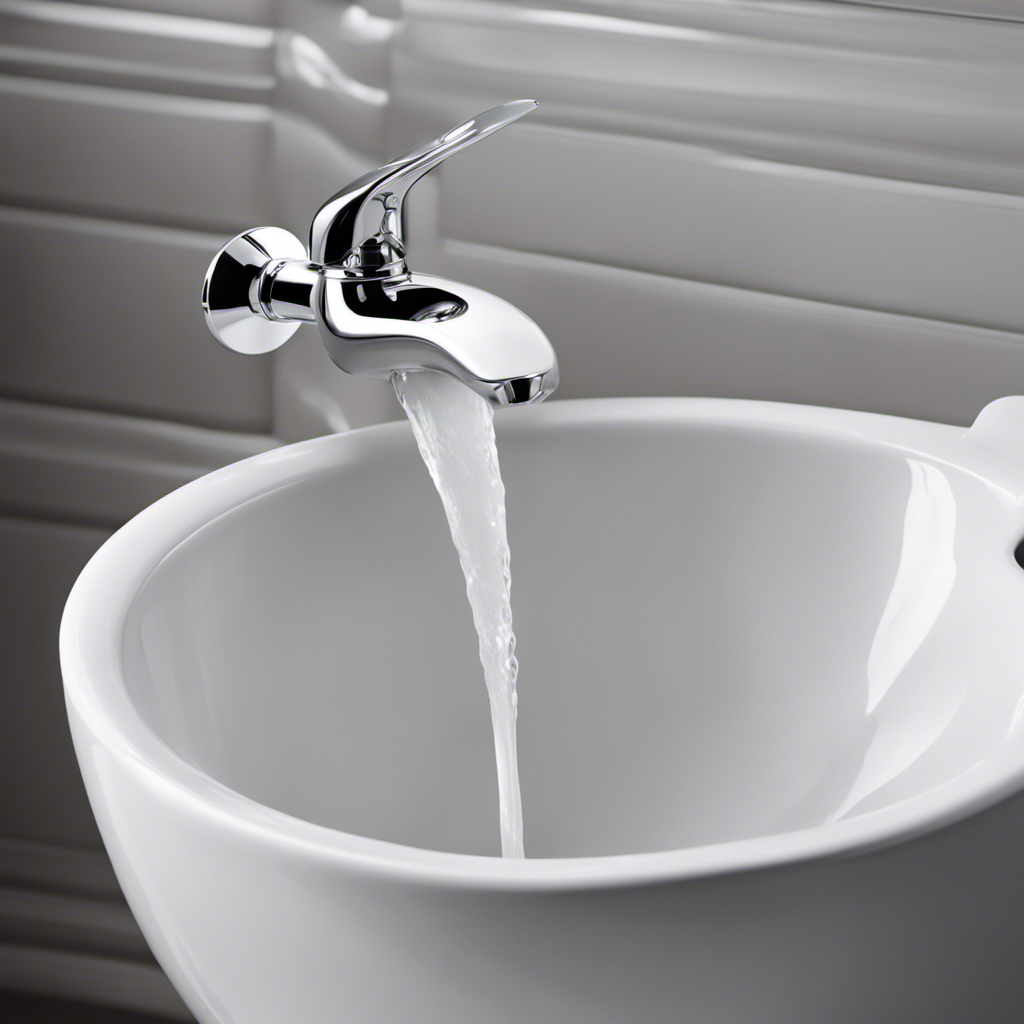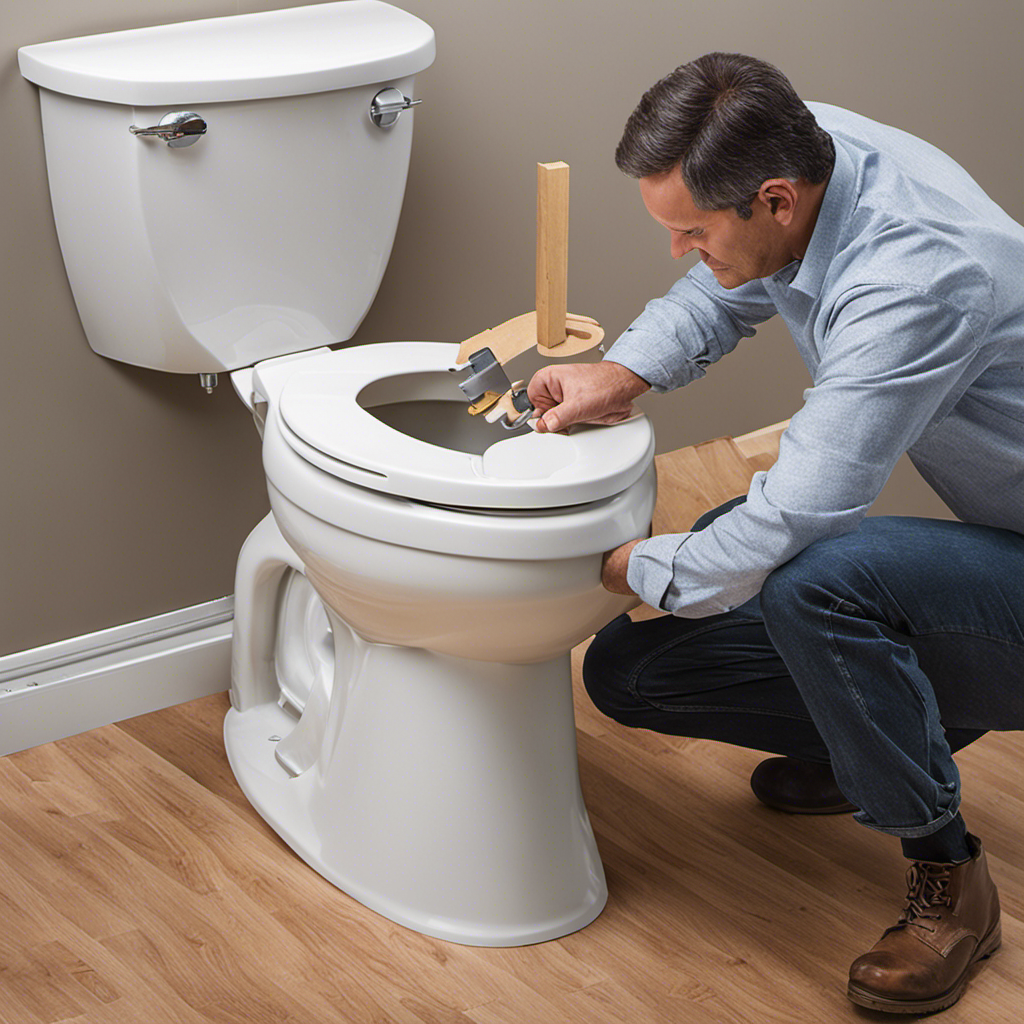Imagine you’re in the middle of a peaceful morning routine, only to discover a leaky toilet tank. Don’t panic! In this guide, I’ll show you how to replace those troublesome tank bolts, restoring your bathroom’s tranquility.
With just a few tools and a bit of know-how, you’ll be able to tackle this task like a pro. Say goodbye to that annoying drip and hello to a fully functional toilet.
Let’s get started!
Key Takeaways
- Use the appropriate tools and materials such as a wrench, screwdriver, new bolts, and check the condition of washers.
- When removing the old bolts, unscrew the nuts and apply penetrating oil to loosen rust. Use pliers or an adjustable wrench, and a hacksaw if necessary.
- When installing the new bolts, place rubber gaskets over the bolt holes, insert the bolts, and secure them with washers and nuts. Tighten the nuts until snug, avoiding excessive force and not using rubber gaskets.
- To adjust the tank position, inspect for visible gaps, loosen the bolts holding the tank to the bowl, gently shift the tank until aligned with the bowl, and then tighten the bolts without overtightening. Ensure the tank sits evenly on the bowl without gaps.
Tools and Materials Needed
To replace the toilet tank bolts, you’ll need a wrench, a screwdriver, and new bolts.
Choosing the right bolts is crucial to ensure a proper fit and avoid future leaks. When selecting new bolts, make sure they are the correct length and have the right thread size for your toilet model.
Common mistakes to avoid include using bolts that are too short, which can cause the tank to be unstable, or using bolts with the wrong thread size, which may not create a tight seal.
It is also important to check the condition of the washers that come with the bolts, as worn or damaged washers can lead to leaks.
Now that we have the necessary tools and materials, let’s move on to removing the old bolts.
Removing the Old Bolts
First, you’ll need to unscrew the nuts securing the old bolts in place.
Removing the old bolts from a toilet tank can be a bit challenging, but with the right techniques, it can be done smoothly.
One common problem with old bolts is that they can become rusted or corroded over time, making them difficult to remove. To tackle this issue, it’s helpful to apply a penetrating oil, such as WD-40, to the nuts and bolts. This will help loosen the rust and make it easier to unscrew them.
Another technique is to use a pair of pliers or an adjustable wrench to grip the bolt tightly while turning the nut counterclockwise.
If the bolts are still stubborn, you may need to use a hacksaw to carefully cut through the bolts. Remember to take your time and be patient to avoid damaging the toilet tank.
Installing the New Bolts
Now that you’ve successfully removed the old bolts, it’s time to install the new ones.
When installing toilet tank bolts, it is important to follow the proper tightening technique to ensure a secure and leak-free connection.
Start by placing a rubber gasket over each bolt hole on the bottom of the tank. Insert the bolts through the holes and secure them with washers and nuts. Use a wrench to tighten the nuts, but be careful not to overtighten, as this can crack the porcelain. A good rule of thumb is to tighten until snug and then give an extra quarter turn.
Common mistakes to avoid include using excessive force, which can damage the toilet or cause leaks, and not using the rubber gaskets, which can lead to leaks as well.
With the new bolts securely in place, we can now move on to adjusting the tank position.
Adjusting the Tank Position
After securing the new bolts, it’s important to make any necessary adjustments to the tank position. Here are some steps to help you in realigning and securing your toilet tank:
-
Inspect the tank: Check for any visible gaps between the tank and the bowl. If there are any, it means the tank needs to be adjusted.
-
Loosen the bolts: Use a wrench to slightly loosen the bolts that hold the tank to the bowl. This will allow you to move the tank and make the necessary adjustments.
-
Align the tank: Gently shift the tank until it is aligned with the bowl. Make sure it sits evenly on the bowl without any gaps.
-
Tighten the bolts: Once the tank is properly aligned, tighten the bolts using a wrench. Be careful not to overtighten, as it may damage the tank or bowl.
Testing for Leaks
To check for leaks, make sure to carefully examine the area where the tank connects to the bowl. This is a common area for leaks to occur, so it’s important to pay close attention during the inspection process. One of the most common mistakes people make when testing for leaks is not thoroughly checking this connection point. It’s important to ensure that the bolts connecting the tank to the bowl are tight and secure. If there are any signs of water leakage or dampness, it’s likely that there is a problem with the seal. One troubleshooting tip is to tighten the bolts if they are loose. Another tip is to replace the rubber gasket if it is worn or damaged. By addressing these issues, you can effectively test for leaks and ensure that your toilet is functioning properly.
| Common Mistakes | Troubleshooting Tips |
|---|---|
| Not checking connection point | Tighten loose bolts |
| Ignoring signs of leakage | Replace worn or damaged rubber gasket |
| Neglecting to inspect the seal | Ensure bolts are tight and secure |
Conclusion
In conclusion, replacing toilet tank bolts is a simple task that can be done in just a few steps. By following the instructions and using the right tools, you can easily upgrade your bathroom without the need for a professional plumber.
Did you know that a leaking toilet can waste up to 200 gallons of water per day? By replacing the bolts and ensuring a tight seal, you can prevent water wastage and save money on your water bill.
So why wait? Get started on replacing those old bolts and enjoy a leak-free toilet today.










